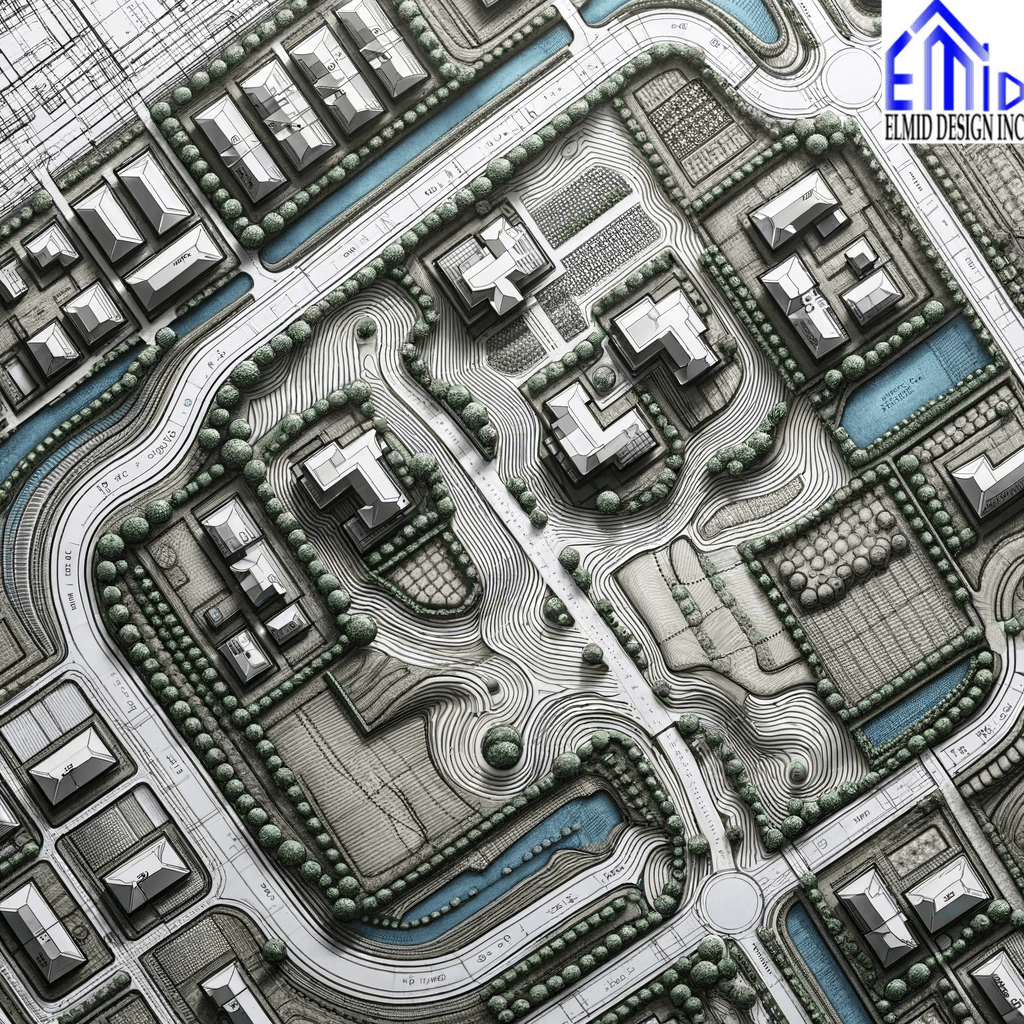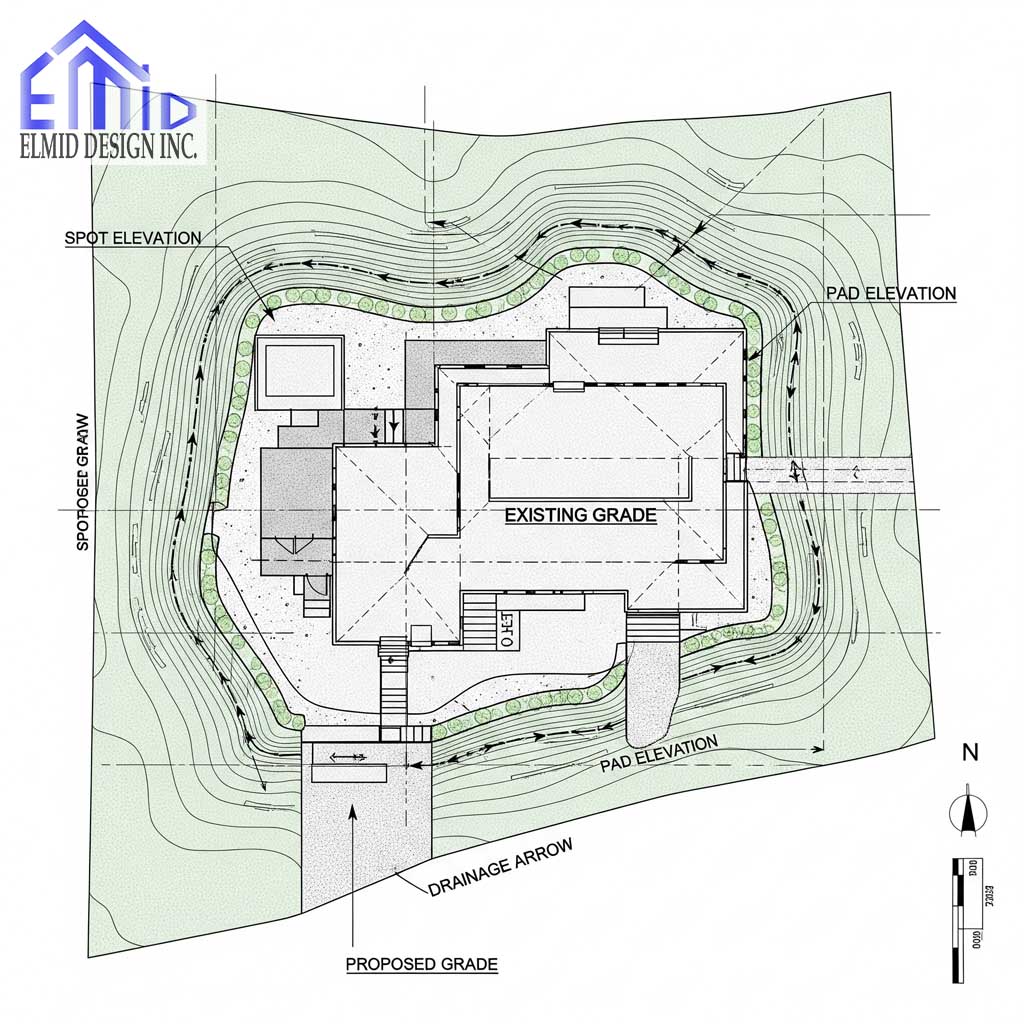Every property redevelopment or new build in Richmond Hill needs a grading plan Richmond Hill to guide surface drainage, protect neighbors, and meet local law. A clear grading plan demonstrates your expertise and builds trust with readers. Keep reading to discover how Richmond Hill requires, evaluates, and enforces these plans.
Key Takeaways
This blog underscores the legal need for a grading plan in Richmond Hill and highlights what the city expects from your submission. It emphasizes proper preparation by licensed professionals and explains how Elmid Design Inc adds credibility by delivering expert, trustworthy support.
Why the Grading Plan Matters in Richmond Hill
A grading plan Richmond Hill reshapes land with attention to drainage, slopes, and safety. The plan prevents water pooling near your foundation and avoids runoff onto neighbors. It ensures your project aligns with the city’s engineering standards and avoids enforcement issues.
Richmond Hill does not grant Site Alteration Permits without a professional‑prepared grading plan. The city reviews excavation, fill, landscaping, and new residential builds to confirm compliance. Submitting a high‑quality plan shows your respect for property integrity and professional accountability. Poor or missing grading plans can lead to delays, fines, and legal actions.
Who Must Prepare the Grading Plan Richmond Hill
Richmond Hill mandates that only a licensed Professional Engineer or Ontario Land Surveyor may prepare a grading plan Richmond Hill. This requirement ensures the plan meets technical accuracy and ethical standards. The professional certifies the plan’s compliance via stamp and signature as proof of accountability.
Relying on an expert adds expert authority to your application and reflects well on your credibility. Including this detail reinforces compliance, reduces risk, and underlines the expertise behind your project. It also strengthens your standing under Google’s EAT principles and reassures both readers and officials.
What the Grading Plan Must Include
A compliant grading plan Richmond Hill includes the title block with permitted notes, lot details, north arrow, scale, geodetic benchmark, and professional certification. It shows legal boundaries, easements, existing and proposed elevations, and contour lines.
If your project includes a swimming pool, the plan must also map out tree protection fencing, proposed tree removals, and replacement tree locations and sizes. These specifics demonstrate that you respect the natural environment and abide by urban forestry rules.
Grading Standards You Must Meet
Richmond Hill specifies that yard slopes must generally range between two and five percent to manage water flow properly. Driveways should slope away from your home, have at least two percent grade, and preferably stay below five percent unless justified. Reverse‑slope driveways are not allowed.
Transition slopes must stay within defined limits. Retaining walls must use durable materials like concrete or stone block, be on private property, and include engineer certification. Meeting these standards shows that your plan is structurally sound and safe.
Permit Submission and Approval Process
To apply for a Site Alteration Permit in Richmond Hill, you submit your grading plan Richmond Hill in PDF form. The city evaluates the plan against the Site Alteration By‑law and Division D engineering standards. A security deposit ensures that you follow through on construction as submitted.
Once your project finishes, inspectors confirm compliance. Completing required improvements allows you to reclaim your deposit. This structured process, backed by secure planning and verification, ensures your work meets both engineering and regulatory expectations.

How a Grading Plan Prevents Water Damage
A properly executed grading plan Richmond Hill redirects water away from your home and reduces flood risks. If your property has poor grading, water collects near your foundation and eventually enters your basement or crawl space. Over time, this causes mold, mildew, and structural failure. A compliant plan prevents runoff from crossing onto neighboring lots and avoids drainage disputes. Richmond Hill prioritizes lot‑by‑lot stormwater management to protect public and private infrastructure. When you prepare your plan correctly, it supports sustainable development and demonstrates both engineering integrity and public responsibility.
Common Mistakes to Avoid in Your Grading Plan
Many homeowners and even contractors submit incomplete or noncompliant plans to the City of Richmond Hill. Forgetting legal easements, proposing unacceptable slopes, or mislabeling benchmark elevations are frequent issues. These errors trigger rejections, permitting delays, and financial setbacks. To avoid complications, use licensed experts familiar with municipal standards. Firms like Elmid Design Inc offer certified grading plans that Richmond Hill accepts without unnecessary revisions. Choosing the right provider ensures that you meet every technical and legal detail without wasting time. A clean, complete plan reinforces trust and demonstrates project professionalism.
The Role of Retaining Walls in Grading Plans
Richmond Hill’s engineering standards make it clear that retaining walls cannot be improvised. Each wall must be designed by a licensed Professional Engineer and placed completely within the private property line. The city prohibits the use of timber or other degradable materials. Your grading plan Richmond Hill must show clear setbacks, structural notes, and material specifications. Retaining walls also impact stormwater flow and neighbor elevation differences, so your plan must address both vertical loads and surface runoff. Including these elements strengthens your permit application and shows your engineering accountability.
Environmental Impact of Poor Grading
Improper grading disrupts natural watercourses, erodes topsoil, and increases runoff volume. In Richmond Hill, new development and infill housing often disturb green areas. Without a clear grading plan Richmond Hill, the land suffers long‑term damage. A well‑designed plan preserves tree root zones, maintains soil stability, and respects watershed guidelines. The city enforces strict erosion controls and uses design standards to prevent unnecessary deforestation. Your grading plan should promote sustainability and follow all local standards to limit environmental loss. This approach aligns with EAT by showing concern for community health and ecological safety.
How Elmid Design Inc Enhances Your Grading Plan
Elmid Design Inc is a trusted engineering firm with a Certificate of Authorization from Professional Engineers Ontario. Their team brings specialized experience in preparing compliant grading plan Richmond Hill drawings for all property types. Whether you’re developing a single residential lot or modifying existing grading for a pool installation, Elmid Design Inc handles technical and legal requirements from start to finish. Their commitment to accuracy and code compliance reflects their engineering expertise. Partnering with qualified professionals reinforces your project credibility, supports timely approvals, and reduces long‑term risks.
Why You Need a Site Visit Before Planning
No grading plan reaches accuracy without a site visit. Richmond Hill’s elevation data and zoning maps help but can’t replace real measurements. A professional must assess current grading, existing trees, hard surfaces, and neighboring elevations. This physical inspection ensures your grading plan Richmond Hill matches real‑world conditions. Errors in grade lines, slope direction, or catchbasin locations often stem from guesswork or outdated site information. Verifiable field data prevents setbacks, supports accurate calculations, and aligns with city expectations. A complete plan starts with boots on the ground and professional instruments.
How to Read and Understand Your Grading Plan
Many homeowners receive their grading plan but don’t know how to interpret it. Key features like elevation points, swale directions, and slope arrows provide the foundation for surface drainage. Your grading plan Richmond Hill also includes boundary lines, easements, and location of catchbasins or retaining walls. Understanding these symbols helps you monitor construction and ensure builders follow the approved layout. Elevations should always decrease from the foundation toward the lot edges. Knowing what each line and label represents keeps you informed, minimizes on‑site errors, and improves communication with contractors.
How Grading Plans Affect Property Resale Value
Properties with approved grading plans hold higher value in Richmond Hill’s competitive market. Buyers gain confidence knowing the land drains properly, reducing the chance of flooding or water damage. Municipal records showing past Site Alteration Permit approvals indicate that the property meets Richmond Hill’s engineering standards. A detailed grading plan Richmond Hill signals quality development and lowers post‑purchase repair risks. If your project includes retaining walls or stormwater control structures, future owners benefit from knowing these were engineered and permitted. Every plan you submit today adds value for tomorrow.
Legal Consequences of Ignoring Grading Requirements
Overlooking the need for a grading plan Richmond Hill invites costly legal complications. Richmond Hill enforces site alteration bylaws with inspections and fines for unauthorized land changes. Property owners who bypass this process face stop-work orders and mandatory corrective actions. If runoff causes damage to neighboring lots, civil liability becomes a real risk. A proper grading plan prevents such issues by documenting intent and receiving official approval. It proves your project complies with municipal code, protecting you from penalties while demonstrating that your development respects shared infrastructure.
How to Streamline the Permit Process
To reduce delays, prepare your grading plan Richmond Hill with full accuracy and attach all required documentation before submission. Avoid assumptions about slopes or existing elevations, as Richmond Hill’s review staff check every detail. Hire qualified professionals early to speed up plan creation and ensure compliance. Include tree protection plans and stormwater drainage notes if required. Using a clear site strategy and staying proactive throughout review stages improves turnaround times. This strategic approach shows technical competence, minimizes permit rejection, and confirms your project meets city expectations from the start.
Why Builders Rely on Professional Engineers
Builders in Richmond Hill trust licensed engineers for their grading plans because the process demands more than basic drafting. Creating a grading plan Richmond Hill requires an understanding of geodetic benchmarks, municipal design criteria, and hydrological principles. Engineers not only certify the plan but also assess how lot grading interacts with surrounding terrain and infrastructure. Their insights prevent surface water conflicts, soil displacement, and unnecessary construction amendments. Choosing an engineer strengthens your submission’s accuracy and helps maintain construction timelines. This collaboration improves project reliability and reduces long-term structural concerns.
Seasonal Considerations for Grading Work
Weather impacts the success of grading projects more than most people expect. In Richmond Hill, the ideal time to implement a grading plan Richmond Hill falls between late spring and early fall when soil conditions remain workable and less saturated. Winter frost and early spring melt disrupt soil structure and make grading both inefficient and noncompliant. Contractors risk failure if grading proceeds during freeze-thaw cycles or wet ground periods. Therefore, planning ahead allows time for proper execution during suitable weather windows. Following seasonal best practices supports construction quality and ensures long-term durability.
What Happens During the Final Inspection
Once construction concludes, Richmond Hill sends inspectors to verify that your grading plan Richmond Hill was followed exactly. They check elevations, swale placement, slope gradients, and final grading against the approved drawings. Deviations from the plan result in rework orders or holdbacks from your security deposit. Final inspections provide closure and assurance that drainage and structural performance align with the engineering design. Compliance at this stage confirms the success of your planning and execution. It also releases your deposit and secures peace of mind for property owners and neighbors alike.
Importance of Ongoing Maintenance
A completed grading plan still needs periodic maintenance to remain effective. Richmond Hill properties may shift naturally due to settlement, erosion, or landscaping changes. If soil shifts create depressions or disturb swales, water no longer flows properly. Homeowners must inspect surface grades regularly, especially after major weather events. Maintaining your grading plan Richmond Hill means adjusting surface material, cleaning catchbasins, and restoring contours as needed. Consistent upkeep protects your foundation, prevents water intrusion, and preserves city compliance. Proactive care ensures your original investment in grading remains effective long after completion.
Why Property Investors Prioritize Grading Plans
Serious investors view a valid grading plan Richmond Hill as essential for both compliance and long-term property value. It prevents post-sale liabilities and supports future development with documented approval history. New construction gains more resale leverage when grading plans show stamped engineering approval and municipal acceptance. Lenders also favor properties with completed site work and drainage control. Without this, appraisals drop and financing may stall. Investors who focus on full compliance benefit from smoother transactions, confident buyers, and greater returns. A grading plan becomes part of your asset’s reputation.
Future Trends in Residential Grading
As Richmond Hill grows, its grading requirements continue to evolve alongside urban intensification and climate considerations. Modern grading plan Richmond Hill submissions may soon integrate smart drainage technologies and low-impact development strategies. Planners are exploring ways to minimize impervious surfaces and use swales, rain gardens, and permeable paving. Digital elevation models and automated inspections are also influencing how permits get reviewed and enforced. Staying ahead of these trends helps professionals and homeowners submit forward-thinking plans that anticipate regulatory shifts. Future compliance starts with today’s awareness and readiness.
Advanced Engineering Behind a Grading Plan
A strong grading plan Richmond Hill relies on more than visible slopes or simple measurements. Behind every approved plan sits a layered engineering process that analyzes stormwater behavior, load-bearing limits, and land contour interaction. Engineers use geotechnical data, topographical mapping, and surface modeling to predict how water flows and how structures respond to environmental stress. Their calculations guide placement of swales, catchbasins, and retaining walls with precise elevations and materials. This technical process prevents drainage failures and guarantees that the proposed land use supports long-term development.
How Topographic Surveys Improve Grading Plans
Topographic surveys provide the foundation for an accurate grading plan Richmond Hill. These surveys document elevation points, terrain features, and existing conditions with real-time measurements. They allow engineers to model how the ground behaves when shaped or developed. Without this data, assumptions lead to flawed grading lines, unrealistic drainage paths, or noncompliant slopes. Richmond Hill’s engineering department requires these survey details in every submission. Incorporating reliable field data into your grading plan ensures it matches the natural site and supports accurate stormwater design from the start.
Digital Tools Used in Modern Grading Plans
Engineering teams now rely on advanced software like AutoCAD Civil 3D and GIS-based modeling to create detailed grading plan Richmond Hill documents. These tools allow experts to visualize land grading in three dimensions, test drainage flows, and simulate post-construction behavior. The software integrates zoning rules, slope formulas, and building setbacks to generate layouts that meet Richmond Hill’s guidelines. These digital tools reduce human error and speed up revisions when inspectors require updates. Their accuracy supports better planning, improves permit approval rates, and reflects professional-level plan creation.
Reducing Costs Through Grading Efficiency
Efficient land grading saves money by minimizing soil movement, limiting retaining wall construction, and reducing stormwater infrastructure requirements. A well-designed grading plan Richmond Hill uses natural contours wherever possible to limit excavation. Engineers assess ways to redirect water using shallow swales instead of pipes or pumps. Every design choice impacts construction timelines and material costs. Richmond Hill supports these efficiencies when they meet performance standards. Developers who prioritize grading efficiency not only lower their costs but also enhance project sustainability and avoid unnecessary rework during inspection.
How Tree Protection Affects Grading Design
In Richmond Hill, tree preservation directly influences grading layouts and slope planning. Municipal bylaws protect tree root zones that cannot be compacted or disturbed during site alteration. A valid grading plan Richmond Hill must outline how grading avoids damaging protected trees. Engineers adjust slopes and reroute drainage channels to preserve natural vegetation. Plans must include tree protection fencing and calculate offset zones around trunks. These requirements not only support environmental goals but also ensure compliance during permit review. Projects that ignore tree impacts risk fines, delays, or permit denial.
Incorporating Stormwater Management Features
Proper stormwater design is essential in any grading plan Richmond Hill. Plans must include elements that handle runoff from roofs, driveways, and landscaping surfaces. Engineers use surface swales, infiltration trenches, and grade breaks to manage flow. Richmond Hill expects on-site retention where possible and discourages reliance on neighboring properties. The grading plan must show how water travels from source to outlet without pooling. Stormwater plans also factor in erosion control, soil saturation, and flood zone compliance. Including these details confirms the development protects surrounding lands and infrastructure.
Grading Considerations for Infill Housing
Infill developments often present unique grading challenges due to close lot boundaries and existing neighboring structures. A successful grading plan Richmond Hill balances new elevations with those already in place. Engineers must ensure that the new design neither floods adjacent properties nor blocks shared drainage paths. Side yard swales must remain functional, and rear yard outlets need clear access. Plans may require creative grading strategies like narrow swales, stepped retaining walls, or vertical transitions. Addressing these complexities signals technical mastery and promotes smooth approval through Richmond Hill’s review process.
Frequently Asked Questions
What is the purpose of a grading plan in Richmond Hill?
A grading plan in Richmond Hill ensures proper drainage and slope management, helping prevent water damage and property disputes. It also satisfies municipal bylaws and engineering standards for residential and commercial development.
Who can prepare a grading plan for Richmond Hill?
Only licensed Professional Engineers or Ontario Land Surveyors can prepare and certify grading plans in Richmond Hill. The city requires stamped drawings to verify compliance and professional accountability.
When do I need a grading plan?
You need a grading plan for most new builds, infill developments, additions, and landscaping projects that alter existing surface elevations. Richmond Hill also requires one for swimming pool permits and certain tree removals.
How long does it take to get a grading plan approved?
Approval times vary but submitting a complete and accurate plan prepared by a qualified expert usually speeds up the process. Most applications get reviewed within a few weeks if no revisions are required.
Can I make changes to my grading plan after approval?
You can make changes, but you must resubmit revised drawings for review and approval. Unauthorized alterations may result in inspection failure, legal issues, or the forfeiture of your security deposit.

Why Elmid Design Inc is the Trusted Choice for Grading Plans in Richmond Hill
Elmid Design Inc is a licensed engineering firm with a Certificate of Authorization from Professional Engineers Ontario, specializing in detailed grading plan Richmond Hill services. With deep knowledge of local bylaws, design standards, and stormwater management, the team delivers precise, city-approved plans for residential, infill, and pool projects. Known for accuracy, compliance, and fast turnaround, Elmid Design Inc ensures your development meets Richmond Hill’s strict requirements while protecting your property and investment. Their proven expertise reflects the highest standards of engineering excellence and professional integrity.
Geographic Locations That We Service:
Our Licensed Professional Engineers specializing in Engineered Site Grading Plans offer the best-engineered site grading plan, lot grading and erosion plan, and drainage plan to obtain site plan approval and building permits in Ontario, including a wide range of municipalities. Each area boasts unique features and requirements, making our tailored approach essential for success.
Toronto and Surrounding Areas
In the vibrant heart of Ontario, we service Toronto (City of Toronto) and surrounding areas. Additionally, we cover Oshawa (City of Oshawa), Pickering (City of Pickering), and Clarington (Municipality of Clarington). Furthermore, our expertise extends to Ajax (Town of Ajax), Whitby (Town of Whitby), Brock (Township of Brock), Scugog (Township of Scugog), and Uxbridge (Township of Uxbridge).
Halton Region
Moving to the Halton Region, our services encompass Burlington (City of Burlington) and Halton Hills (Town of Halton Hills). Also included are Milton (Town of Milton) and Oakville (Town of Oakville).
Peel Region
In the Peel Region, we provide services in Brampton (City of Brampton), Mississauga (City of Mississauga), and Caledon (Town of Caledon).
York Region
Our services in the York Region cover Vaughan (City of Vaughan), Aurora (Town of Aurora), and East Gwillimbury (Town of East Gwillimbury). We also cater to Georgina (Town of Georgina), Markham (City of Markham), Newmarket (Town of Newmarket), Richmond Hill (City of Richmond Hill), Whitchurch-Stouffville (Town of Whitchurch-Stouffville), King (Township of King), and Bradford-West Gwillimbury (Town of Bradford-West Gwillimbury). Each municipality here offers a distinct setting, requiring our specialized approach.
Other Southern Ontario Cities and Towns
We also serve many other cities and towns in Southern Ontario. These include Hamilton (City of Hamilton), St. Catharines (City of St. Catharines), Niagara on the Lake (Town of Niagara on the Lake), Brant (County of Brant), Cambridge (City of Cambridge), Kitchener (City of Kitchener), Waterloo (City of Waterloo), and Woodstock (City of Woodstock). Furthermore, we operate in Guelph (City of Guelph), Centre Wellington (Township of Centre Wellington), Shelburne (Town of Shelburne), Orangeville (Town of Orangeville), New Tecumseth (Town of New Tecumseth), Essa (Town of Essa), Collingwood (Town of Collingwood), Wasaga Beach (Town of Wasaga Beach), Barrie (City of Barrie), Midland (Town of Midland), Orillia (City of Orillia), Ramara (Town of Ramara), Minden Hills (Town of Minden Hills), North Kawartha (Town of North Kawartha), Kawartha Lakes (City of Kawartha Lakes), Peterborough (City of Peterborough), Selwyn (Town of Selwyn), and Brighton (Municipality of Brighton).




